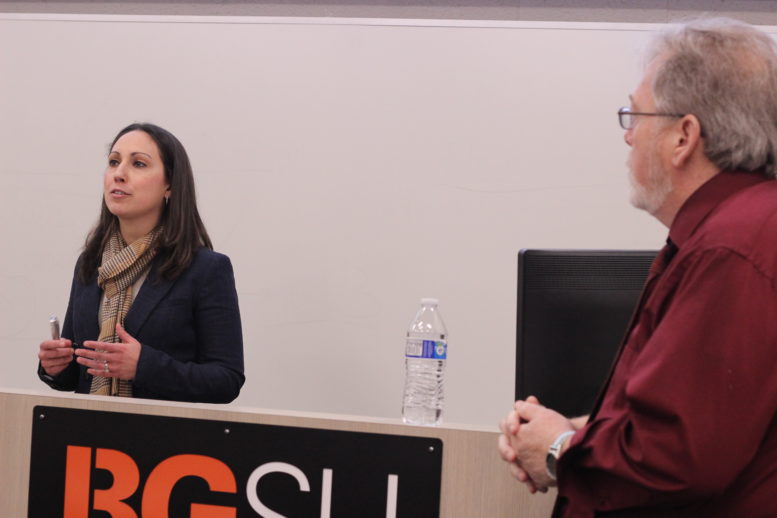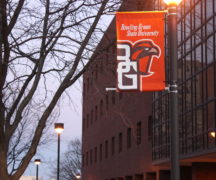By DAVID DUPONT
BG Independent News
Bowling Green State University faculty association members and guests received an update on what to look for in the coming Ohio legislative session.
The news presented by Sara Kilpatrick, Ohio Conference executive director of the AAUP and a BGSU graduate, and John McNay, the president of the AAUP Ohio Conference, discussed a range of issues from textbooks to the cost of intercollegiate athletics.
Republicans, Kilpatrick said, have heavy majorities in both houses. That means they can override the governor’s veto. It also means they can pass bills as emergency measures. If approved as an emergency, that legislation is not subject to be challenged by a referendum.
Still, Kilpatrick said, “it’s very difficult to manage a caucus with that many members.” While they are all Republicans, they represent a range of views.
The key legislative players are State Senator Randy Gardner, who chairs the higher education subcommittee of the senate education committee. Kilpatrick said given his long service in both the Senate and the House, he is “well versed” on the issues.
She advised those attending that as his constituents, they had “a good opportunity to bend his ear.”
On the House side, Rick Perales chairs the subcommittee on higher education finance and Mike Duffey, chairs the Higher Education and Workforce Development Committee.
Kilpatrick said Duffey is a moderate and “the most well-informed” legislator on higher education issues.
Perales, however, is still learning the ropes.
While everyone is in agreement that the cost of higher education is an issue, the various parties’ diagnosis of the situations differ.
McNay said that it was the AAUP that pushed for the creation of a task force on efficiency and affordability.
One issue that’s come out of the task force is an emphasis on controlling the cost of textbooks. The task force charged universities with looking for solutions, but before those could be developed, Gov. John Kasich put a proposal in his budget to have universities pay for textbooks. That plan appears to be a flop.
Perales told McNay before he testified that the committee had already heard how bad the proposal was.
It had multiple problems including the cost to institutions more bureaucracy on campuses to administer it and that it would amount to some students subsidizing the books for others through a new fee.
“They think we write these books and get wealthy,” he said. In reality “my book made $33.”
“The real issue is that textbooks cost too much,” Kilpatrick said. “That’s something neither faculty nor institutions control.”
This concern comes up as it appears funding will be close to flat for the biennium.
Kasich is proposing 1-percent increases in each of the two years. (BGSU president Mary Ellen Mazey has been saying there would be no increase in second year. Kilpatrick said the difference comes in how one accounts for the way money is allocated.)
“That increase doesn’t account for all the other mandates and inflation,” Kilpatrick said.
The budget also calls for a 3.1-percent increase in money allocated for Ohio College Opportunity Grants in the first year and a 2-percent increase in the second year.
This comes after a biennium budget that increased spending. That however has been a rarity, the AAUP graph shows Ohio funding for higher education has decreased 15 percent since 2008. Kilpatrick noted that Gardner likes to point out that those figures are better than most states. Ohio is 31st on the list led by Arizona that cut spending by 55 percent. Only four states raised spending in that period.
“But why not be the best?” McNay said.
They contend that the declines in state funding are what’s driving up tuition.
There are other factors. The state’s public universities as a whole have seen a 121-percent increase in debt, largely because of construction from 2005-2015. BGSU saw its debt increase 23 percent over that period. Only University of Cincinnati had a lower increase.
And while legislators complain about the cost of textbooks, the cost of athletics continues to be subsidized by students. Only Ohio State’s athletic department brings in enough revenue to break even.
At BGSU, only 41 percent of the $21.8 million athletic budget, fourth lowest among state universities, is covered by ticket sales, contributions and other revenue, according to AAUP figures.
“We’re spending more and more on athletic when adjusted for inflation,” Kilpatrick said. “I’m not against athletics. I don’t know if Bowling Green needs to be a Division I football school.”
One area where the AAUP would like to see more spending is to convert adjunct, or part-time, positions, into full-time positions.
According to AAUP’s numbers, almost 35 percent of BGSU faculty are adjuncts. That puts BGSU in the bottom third of state universities in its reliance on part-timers.
Kilpatrick said it would cost the university 4.5 percent of its budget to convert half those 433 positions into tenure-track positions. It would cost close to 3.7 percent of the budget to convert half those positions into non-tenure track instructorships.
Kilpatrick said that sometimes the reason legislators come up with “crazy ideas” about controlling faculty workload is because their children are being taught by part-time instructors.





